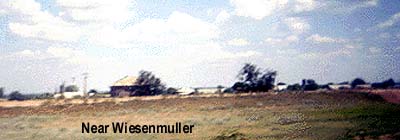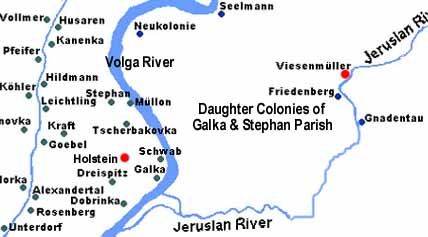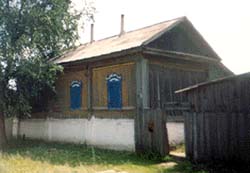(Henry Diel)

(I made some Yauk Winnipeg remarks in Red - KJH )

(I made some Yauk Winnipeg remarks in Red - KJH )
| By 1801 all the land of every individual became the property of the
colony so there could be no more expansion. The people applied to the government
for more land. In 1866, a tract was set aside in the Wiesenseite and sixty-seven
settlements were founded called daughter colonies. The Galka and Stephen
parishes, of which Holstein belonged, founded daughter colonies along
the Jeruslan river, to alleviate their population and land use problems.
Consequently many of the relatives from the original settlements may be
found in the daughter colonies.
Robbers & Kirghiz:
They preferred horse meat and milk to eat. They preyed on the colonists. Also in this area were wild beasts: bears, lynx, wolves. Each family had its own tract of land and more could be leased. The rest was divided into grazing land, land set aside for cutting hay. This land was owned jointly by the colony and divided by lot for cutting grass for the winter feed. They also had a small tract set aside for gardens close to the river so people could carry water for their gardens. This was also divided by lot. |
| Herds:
The colony hired herders to gather all the cattle and sheep every morning to take them out to graze and to bring them back every night. It was the responsibility of the boys to herd the horses. As many horses were used in the day farming, the boys had to nightherd them at times. Doctor:
|
 |
| Town Council:
Each colony had its own town council which decided all disputes. They had a town crier who went through the streets crying the news. When they wanted a town meeting, he cried out the news. Only men went to the meeting. If you didn't show up without a good excuse, you fined ten kopec. Taxes:
Land: ( 1-desyatine
= 2.7 acres)
Fuel & Oven:
Each house had a big adobe oven with a brick floor on which was done the baking. For heat there were two big iron kettles built in. There was a flue to carry off the smoke. You could cook on top too, but most was done on the coals inside the oven. Winter: (
The Meadow side is very close to Manitoba both in Weather and Landscape
|
 |
Preserves: (
The Yauks made enough preserves to last all Winter, then some )
In preparing for winter the women went out and gathered wild berries and canned them or made jellies, expecially wonderberries which didn't need any sugar. They made gallons of watermelon syrup which also didn't need sugar. They canned or dried pears, peaches, plums, apricots, cherries and apples. They dried fish which were plentiful. They also smoked or put them in brine. They made alot of sauerkraut, dill pickles, sour wataermelons and apples. Also every house had crocks in which the milk was poured. They skimmed off the cream for butter or just to mix with watermelon syrup to dunk bread in or to pour over foods. |
| Meat& Drink: (
Grandpa's Dry Summer Sausage the Best - Yauks made tea from herbs for Colds
- wild Camomile )
They killed beef, hogs, sheep, and hung the meat on rafters when it was cold. They smoked some of it. In warm weather they fryed the meat and sausage and put it into crocks and poured lard over it till it was covered. It seems the lard kept it from spoiling no matter how hot it got. From the clabbered milk they made all kinds of cheese. The urn was always brewing. The women went out and dug "Suesholz" roots and dried them for tea. They used real tea also. The coffee was roasted grain and chicory. Each village had a grist mill, either wind or water power. Later some had steam. You could get grain ground for a portion of the grain. Grain:
Bed: (
We all remember the Yauk's German Comforters ! )
Respect: (
My Grandparents were allways respected by younger people )
|
|
|